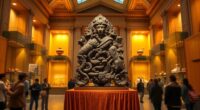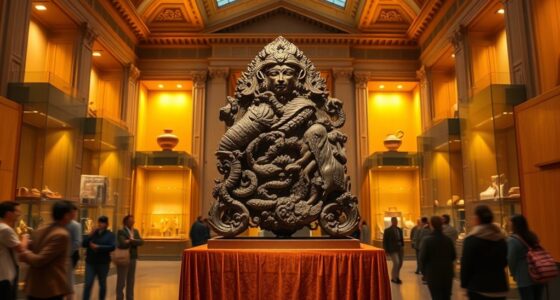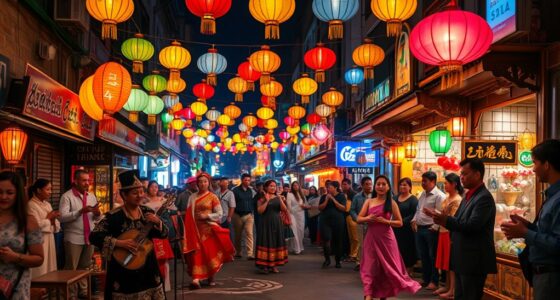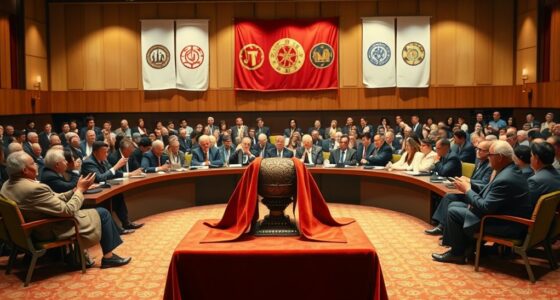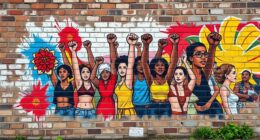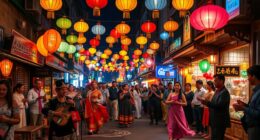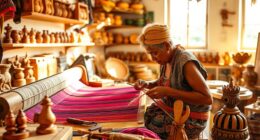Folk art motifs in contemporary art and design bring cultural symbols into modern visuals, connecting past and present. You’ll see traditional patterns, handmade techniques, and natural materials inspire everything from fashion to home decor. Artists reimagine these motifs with new materials, digital tools, and innovative methods, promoting cultural pride and sustainability. If you want to explore how these motifs keep tradition alive while shaping modern aesthetics, there’s more to uncover.
Key Takeaways
- Contemporary artists incorporate traditional folk motifs to preserve cultural identity and create meaningful, emotionally resonant artwork.
- Folk motifs are reimagined with modern techniques and materials, offering fresh interpretations that appeal to diverse audiences.
- Integration of folk symbols in design fosters cultural dialogue, appreciation, and understanding across different communities.
- Modern applications include textiles, fashion, graphic design, and interior decor, blending tradition with innovation.
- Reinterpreting folk motifs helps resist cultural erasure, promote sustainability, and strengthen community pride through artistic expression.
The Role of Symbolism in Folk Art and Its Influence on Modern Visual Language
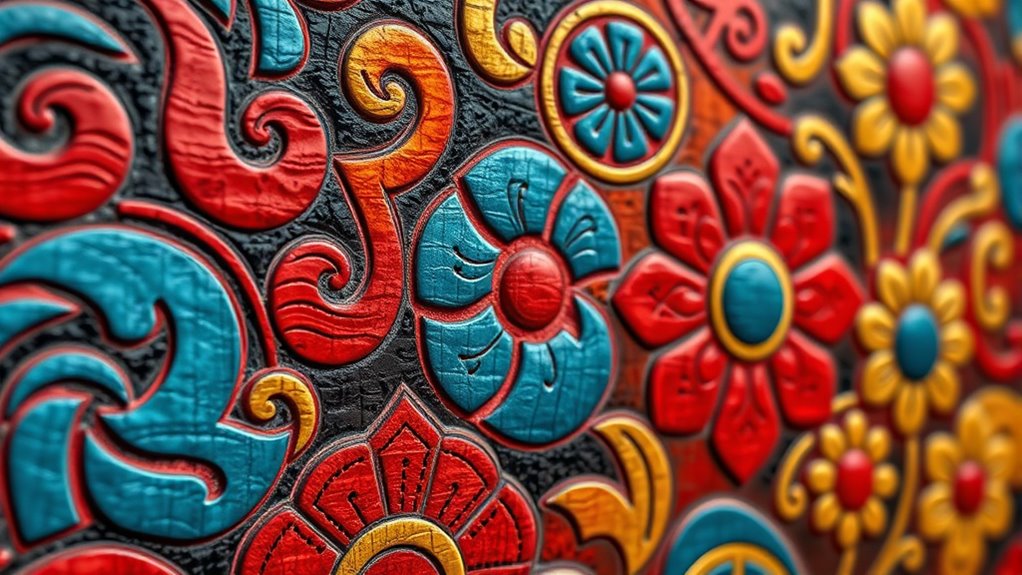
Symbolism plays an essential role in folk art by serving as a visual language that communicates community stories, spiritual beliefs, and cultural values. You’ll notice that folk symbols often tell narratives about local history, myths, and shared traditions, acting as a way to preserve cultural memory. These symbols are usually abstract or stylized, offering layered meanings that go beyond literal depiction. Specific colors and materials are chosen for their symbolic significance, reflecting local customs and beliefs. Many motifs carry spiritual or ancestral importance, grounding the artwork in community spirituality. Some symbols remain intentionally ambiguous to outsiders, protecting traditional knowledge. This symbolic foundation influences modern visual language by creating a universal, emotionally resonant language that emphasizes meaning over realism and connects diverse audiences through shared cultural symbols. Furthermore, the enduring presence of folk motifs in contemporary art and design demonstrates how traditional symbolism continues to inspire innovative visual expressions in today’s globalized world. Recognizing the cultural significance of these symbols helps us appreciate their depth and ongoing relevance. Additionally, understanding the traditional techniques used in folk art provides insight into their enduring aesthetic and symbolic qualities, enriching contemporary design approaches. Exploring cultural preservation efforts highlights how folk symbols maintain their importance across generations and adapt to modern contexts. Moreover, integrating AI-driven analysis can help decode complex folk symbols, fostering a deeper understanding of their meanings and significance in contemporary visual language. Studying symbolic color choices further reveals how specific hues are used to convey particular meanings and emotional responses within different cultural contexts.
Incorporating Intricate Patterns From Folk Traditions Into Contemporary Design Aesthetics
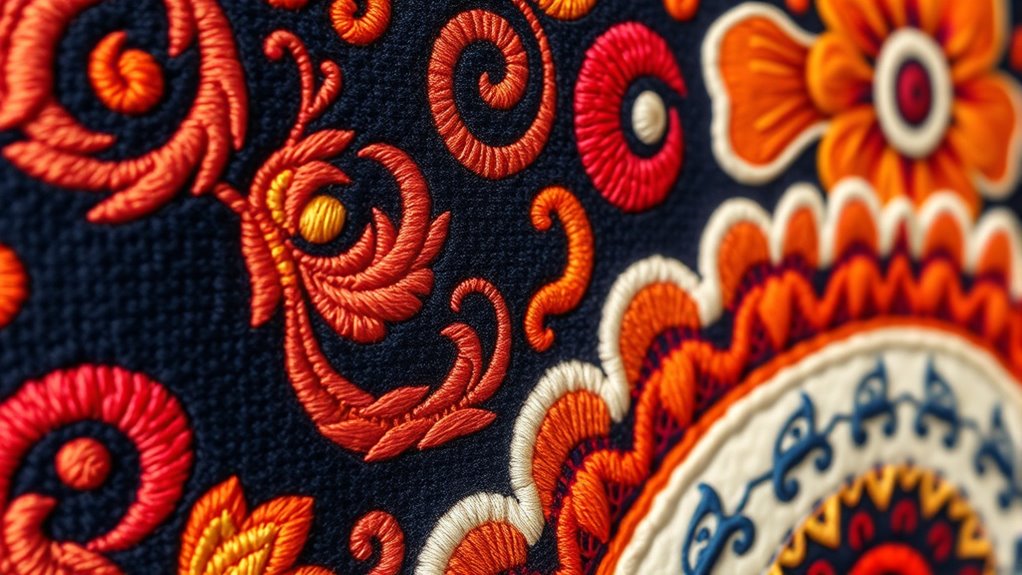
You can incorporate folk patterns into modern design by applying traditional elements directly onto surfaces or by adapting them through simplification and scale. This approach helps preserve the cultural significance of the motifs while making them relevant today. When done thoughtfully, it creates a meaningful connection between heritage and contemporary aesthetics. For example, utilizing folk art techniques with folk-inspired motifs can elevate indoor gardening with cultural storytelling. Additionally, understanding state-specific tax laws can influence how you select and present these motifs in commercial products or art pieces, ensuring compliance and relevance. Incorporating traditional craftsmanship methods can also enhance the authenticity and uniqueness of the designs. Developing cultural intelligence can further deepen the understanding of the motifs’ origins and significance, enriching the creative process.
Traditional Pattern Elements
Traditional pattern elements form an essential bridge between cultural heritage and modern design, allowing artisans and designers to infuse contemporary aesthetics with rich, intricate motifs. Rooted in local customs, nature, and regional symbols, these patterns often tell stories of myths, historical events, or daily life. Handmade techniques like embroidery, weaving, carving, and block printing preserve their authenticity and regional identity. Different cultures develop unique styles based on local materials and traditions, with symbols representing protection, prosperity, or spirituality. Common motifs include floral, geometric, animal, and abstract designs, often framed by border patterns. These elements serve as visual narratives, connecting past and present, and enriching modern creations with deep cultural significance and craftsmanship. Incorporating traditional pattern elements into contemporary design not only celebrates cultural diversity but also fosters a sense of authenticity and uniqueness in modern art. Furthermore, butter symbolism in various cultures highlights the importance of motifs that represent abundance and prosperity, enriching these patterns with deeper meanings. Recognizing the cultural significance of these motifs enhances their value and relevance in contemporary applications. Additionally, understanding the regional origins of motifs can help preserve traditional techniques and promote cultural appreciation in modern contexts. By studying the regional variations, designers can better appreciate the diversity of folk art motifs and incorporate them thoughtfully into their work.
Modern Design Integration
Modern designers seamlessly incorporate folk art motifs into contemporary aesthetics, creating visually striking and culturally rich products. You’ll see this in fashion collections by Anita Dongre and Sabyasachi Mukherjee, where intricate patterns celebrate tradition while feeling modern. In home decor, brands like Fabindia and Jaypore blend folk motifs into lamps, textiles, and furniture, adding texture and authenticity. Graphic design also benefits, with folk elements making logos, branding, and packaging more eye-catching. Product innovation, like Jaipur Rugs’ carpets and Kutch Leather’s accessories, often uses traditional techniques for unique appeal. This integration enhances national styles, giving products a charming, eclectic vibe. Folk art’s influence brings vibrancy, texture, and cultural depth to modern design, making each piece meaningful and visually compelling. Incorporating traditional techniques contributes to the authenticity and distinctiveness of contemporary products.
Cultural Significance Preservation
Incorporating intricate folk patterns into contemporary design helps preserve cultural identities and keeps ancestral narratives alive. You play a crucial role in maintaining these traditions by integrating motifs that reflect community stories, myths, and beliefs. These patterns, often created by untrained artists, encode symbolic meanings—like animals representing mythology, plants symbolizing fertility, or geometric shapes offering spiritual protection. When you use these motifs, you help guarantee their significance endures, fostering cultural pride and understanding. To deepen this connection, consider the following:
| Folk Motifs | Cultural Significance | Contemporary Impact |
|---|---|---|
| Animal symbols | Mythology and nature | Reinforce community bonds |
| Plant patterns | Fertility and growth | Promote cultural storytelling |
| Geometric designs | Spiritual protection | Preserve ancestral wisdom |
A strong understanding of Hopi pottery firing techniques can further enhance your appreciation and accurate representation of these motifs in modern designs.
Reviving Cultural Heritage Through Folk Art Motifs in Today’S Artistic Practices
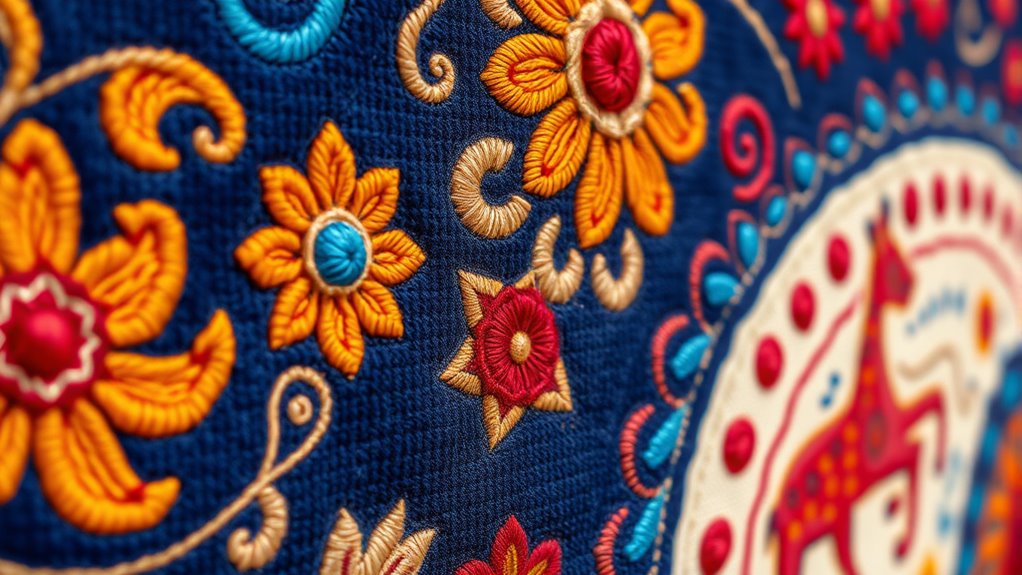
You can see how artists incorporate traditional folk motifs to preserve cultural identity and express heritage. By reimagining these motifs in modern contexts, they create fresh interpretations that honor tradition while appealing to new audiences. This innovative approach helps to maintain cultural heritage and ensures that traditional artistry continues to evolve and resonate in contemporary art and design. Additionally, integrating motifs can serve as a form of resistance against cultural erasure, fostering pride and continuity among communities. The use of folk art motifs also encourages cultural dialogue, promoting understanding and appreciation across diverse audiences. Moreover, embracing authenticity in these motifs enhances their significance and deepens their impact in contemporary works.
Cultural Identity Preservation
Folk art motifs serve as essential symbols that preserve and revive cultural identities in today’s artistic practices. They act as living archives, capturing community values, beliefs, and stories across generations. These motifs document historical events, legends, and shared experiences, embodying cultural memory while remaining adaptable to contemporary contexts. By passing down traditional skills and philosophies, folk art fosters a sense of belonging and pride. You’ll find grassroots organizations, museums, and community efforts actively supporting artisans and promoting traditional crafts. Symbols, colors, and themes visually communicate complex meanings, reinforcing cultural identity. These motifs help keep traditions alive, ensuring continuity amid societal changes.
- Preserve community stories and values
- Educate younger generations
- Promote cultural pride
- Support artisan skills transfer
- Strengthen cultural continuity
Traditional Motifs Reimagined
Traditional folk art motifs are experiencing a vibrant revival as contemporary artists and designers reimagine their meanings and applications. You see this in interior design, where bold, earthy motifs bring cultural richness to modern spaces, and in textiles inspired by traditional fabrics like those from African or Romanian origins. Designers use modern techniques and materials to breathe new life into these motifs, making them relevant today. This revival helps preserve cultural heritage while promoting sustainable practices through local resources. In fashion, designers like Anita Dongre and Sabyasachi incorporate folk art elements into collections, blending tradition with innovation. These motifs also appear in graphic design and packaging, adding cultural depth and visual impact. Overall, reimagining folk art motifs revitalizes tradition, connecting past and present creatively.
Contemporary Artistic Integration
Contemporary artists actively incorporate folk art motifs into their work to preserve and celebrate cultural heritage. By doing so, you help keep traditional techniques alive and foster cross-cultural dialogues. Folk art embodies community identity, beliefs, and history, serving as a rich source of inspiration for modern practices. You might revive age-old methods like hand weaving or wood carving, blending them with contemporary styles to create unique pieces. This integration not only enhances national artistic identity but also sparks innovation. Folk art acts as a bridge connecting past and present, allowing you to explore roots while engaging diverse audiences.
- Preserve ancestral techniques through modern reinterpretation
- Foster cross-cultural understanding and dialogue
- Enhance national style with traditional motifs
- Use folk art as a creative innovation catalyst
- Maintain cultural identity in a globalized world
Blending Folk Art Elements With Modern Materials and Techniques in Mixed Media Works
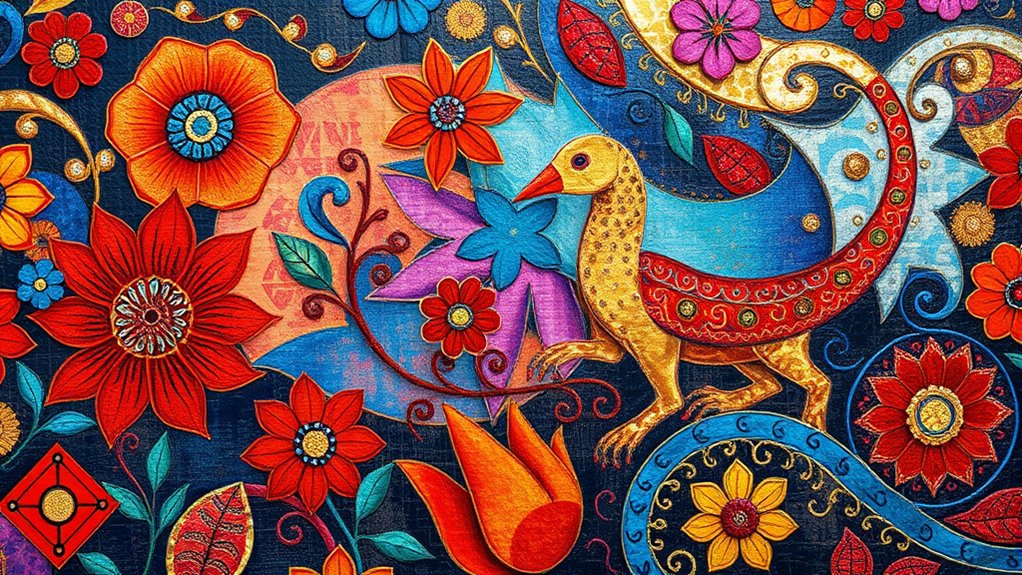
Blending folk art elements with modern materials and techniques in mixed media works opens up exciting creative possibilities, allowing you to reimagine cultural motifs in innovative ways. You can layer different materials like paint, paper, and fabric to build depth, or use collage to incorporate found objects and create textured bases. Stencilling helps add folk patterns precisely, while image transfers and digital printing enable seamless integration of traditional motifs with contemporary visuals. Thick impasto layers add tactile dimension, and natural or recycled materials introduce eco-friendly textures. By combining these techniques with digital tools, you can manipulate folk-inspired designs digitally, enhancing your work’s complexity. This fusion of old and new creates vibrant, multidimensional pieces that honor tradition while pushing artistic boundaries.
Folk Art Inspiration in Fashion, Home Decor, and Product Design
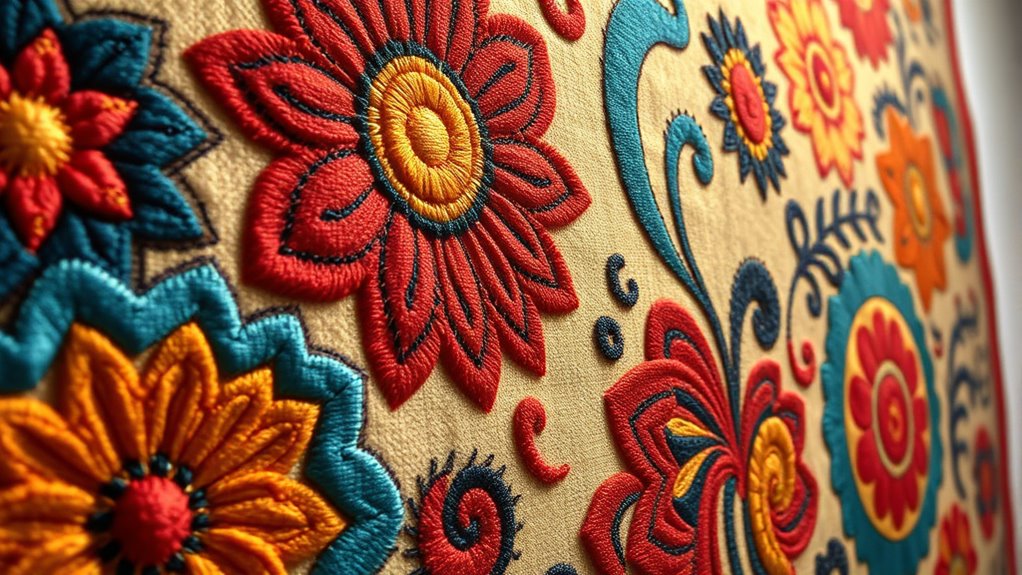
Incorporating folk art motifs into fashion, home decor, and product design breathes new life into age-old traditions, transforming them into vibrant expressions of personal and cultural identity. You’ll notice bold prints and metallic embroidery inspired by Afro-Deco and other folk styles shaping fashion collections. Indigenous craftsmanship, like beadwork and hand-stitched narratives, is revived by young designers emphasizing authenticity. Personalized clothing that tells ancestral stories becomes mainstream, while hyperlocal references—such as kimono streetwear or Andean ponchos—gain global traction through social media. Textiles featuring folk-inspired details like fringe and raw-edge weaving dominate runways.
- Vibrant prints and embroidery
- Handcrafted, narrative-rich designs
- Cultural storytelling through clothing
- Locally inspired fashion trends
- Folk motifs in textiles and accessories
The Global Exchange of Folk Art Motifs and Their Modern Interpretations
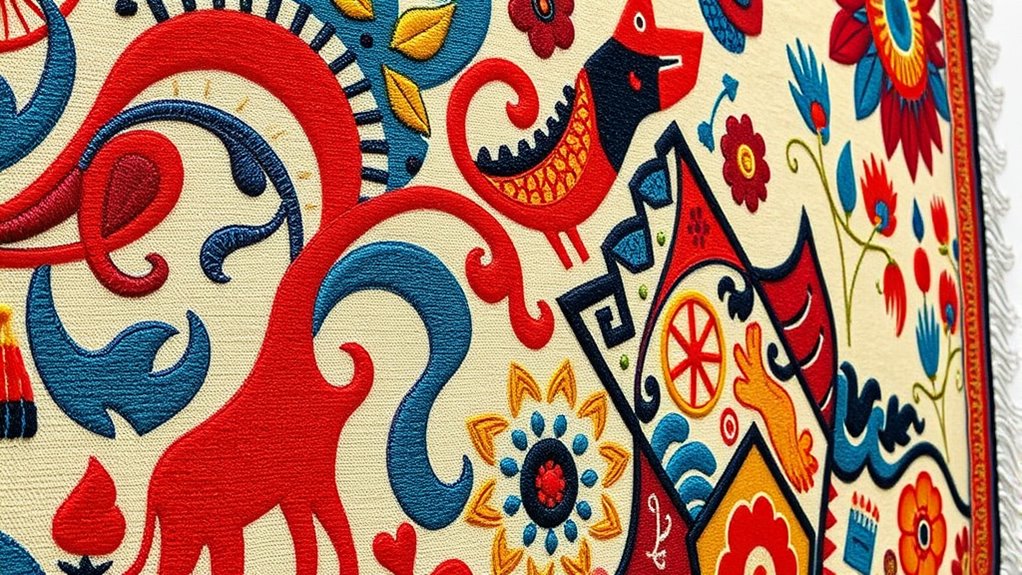
The global exchange of folk art motifs has expanded considerably thanks to cultural exchange programs, international exhibitions, and digital platforms. These channels allow you to access diverse cultural expressions, fostering cross-cultural understanding. Artists and designers worldwide share motifs, blending traditional elements with contemporary styles. Collaborative projects and educational initiatives further promote this exchange, enabling new interpretations. Digital platforms, in particular, make folk art motifs instantly accessible, inspiring artists to reimagine them in modern contexts. As a result, folk motifs influence a broad range of art forms, from fashion to interior design, creating hybrid styles that honor heritage while embracing innovation. This exchange enriches cultural dialogue, helps preserve traditions, and encourages a global appreciation for the diversity and beauty of folk art motifs.
Digital Innovation: Digitizing Folk Art and Its Application in Contemporary Platforms

Digital innovation has transformed the way you preserve and share folk art by making it more accessible and engaging worldwide. High-resolution imaging captures intricate details, while 3D scanning creates detailed digital models, safeguarding artifacts. Metadata collection offers rich context, including artist info and history, stored in digital databases for long-term access. You can explore folk art through virtual exhibitions and interactive platforms, expanding reach and appreciation. Additionally, digital tools like infrared reflectography and UV fluorescence uncover hidden layers and alterations, aiding conservation. You might also use digital printing or 3D printing to reproduce motifs and create new designs. These advances allow folk art to thrive in modern contexts, connecting communities and fostering preservation through innovative technology.
Folk Art’s Contribution to Sustainable and Culturally Rich Modern Design Trends
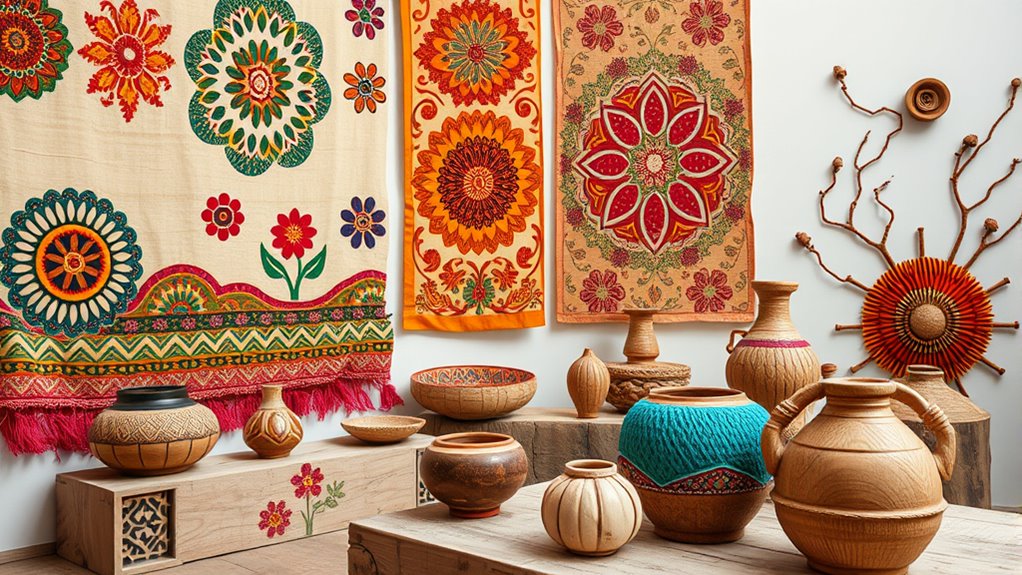
Folk art profoundly influences modern design trends by emphasizing sustainability and cultural richness. It relies on local materials and traditional techniques, reducing dependence on industrial processes. Natural, biodegradable materials like wood, fibers, and stone support eco-friendly principles, while handcrafted methods lower energy use and waste. Folk motifs promote durable, timeless designs, encouraging longevity over fast fashion. Integrating recycled and found materials further reduces resource extraction.
| Traditional Practice | Modern Sustainability Benefit |
|---|---|
| Use of local materials | Less environmental impact |
| Handcrafted techniques | Lower energy consumption |
| Recycled materials | Reduced waste and resource use |
This approach enriches cultural identity, embeds storytelling, and supports eco-conscious, ethically produced designs, fostering both environmental and cultural sustainability.
Frequently Asked Questions
How Do Folk Art Motifs Influence Contemporary Branding and Marketing Strategies?
You see how folk art motifs shape branding and marketing strategies by creating distinctive visuals that stand out. They add authenticity, evoke emotional connections, and tell stories that resonate with consumers. By incorporating traditional patterns into packaging, advertising, and store designs, you build a memorable identity. These motifs also help differentiate your brand, appeal to diverse markets, and position your products as unique and high-quality, fostering loyalty and trust.
In What Ways Are Traditional Folk Art Techniques Adapted for Modern Digital Art?
You can adapt traditional folk art techniques for modern digital art by starting with hand-drawn sketches on tablets to capture authentic designs. Use custom brushes that mimic natural media textures, and create color palettes inspired by folk hues. Incorporate detailed patterns with digital illustration software, blending old and new styles. This approach preserves cultural essence while allowing you to experiment, innovate, and present folk motifs in engaging, contemporary formats.
How Does Incorporating Folk Art Motifs Impact the Sustainability of Contemporary Designs?
Incorporating folk art motifs boosts sustainability by emphasizing handmade craftsmanship and traditional techniques, which often use natural or recycled materials. You can create durable, eco-friendly products that reduce waste and reliance on mass production. This approach encourages reusing materials and supports local artisans, aligning with consumer trends favoring unique, culturally rich, and sustainable items. Overall, it promotes environmentally conscious design that respects cultural heritage and minimizes environmental impact.
What Are the Challenges in Preserving Folk Art Authenticity in Modern Reinterpretations?
Did you know that over 60% of folk artists feel pressure to modernize their work? You face challenges in preserving authenticity as traditions evolve, blending original techniques with new materials and digital tools. Balancing respect for cultural roots with innovation is tough, especially when market demands push for commercialized versions. You need to engage communities, understand historical context, and maintain cultural sensitivity to keep folk art’s true essence alive.
How Do Cultural Exchanges Shape the Evolution of Folk Art Motifs Worldwide?
Cultural exchanges shape folk art motifs worldwide by introducing new ideas, symbols, and techniques from diverse cultures. You’ll see traditional motifs evolve as artists incorporate influences from global interactions, festivals, and markets. This blending leads to innovative expressions that preserve core cultural meanings while adapting to contemporary tastes. Such exchanges enrich folk art, making it more dynamic, relevant, and capable of connecting communities across borders through shared artistic language.
Conclusion
By embracing folk art motifs, you connect deeply with cultural roots while inspiring innovation. Imagine a fashion designer incorporating traditional embroidery into a modern jacket, creating a piece that honors heritage and appeals to current trends. This blend of old and new not only celebrates diversity but also fosters sustainable creativity. As you explore these motifs, you’ll find endless ways to enrich your work, making cultural stories come alive in fresh, compelling forms.


